
About UsThe Numismatic Bibliomania Society is a non-profit organization promoting numismatic literature. For more information please see our web site at coinbooks.org SubscriptionsThose wishing to become new E-Sylum subscribers (or wishing to Unsubscribe) can go to the following web page link MembershipThere is a membership application available on the web site Membership Application To join, print the application and return it with your check to the address printed on the application. Membership is only $15 to addresses in the U.S., $20 for First Class mail, and $25 elsewhere. For those without web access, write to: David M. Sundman, Secretary/TreasurerNumismatic Bibliomania
Society AsylumFor Asylum mailing address changes and other membership questions, contact David at this email address: dsundman@LittletonCoin.com SubmissionsTo submit items for publication in The E-Sylum, just Reply to this message, or write to the Editor at this address: whomren@coinlibrary.com
BUY THE BOOK BEFORE THE COINYou won't regret it! |
- WAYNE'S WORDS: THE E-SYLUM DECEMBER 27, 2009
- SKLOW NUMISMATIC LITERATURE AUCTION SALE #9 CATALOG ONLINE
- NEW BOOK: COINAGE OF THE ANGLO-HANNOVERIAN PERSONAL UNION 1714-1837
- BOOK REVIEW: A GUIDE BOOK OF UNITED STATES COINS (PROFESSIONAL EDITION)
- BACK ISSUES OF REVUE BELGE DE NUMISMATIQUE FOR SALE
- REVIEW: KOLBE STACK FAMILY LIBRARY AUCTION CATALOG
- THE NATIONAL MUSEUM IN JAKARTA, INDONESIA
- MORE ON THE PITTSBURG AND MEXICAN TIN MINING COMPANY MEDAL
- GOLD CERTIFICATES VS FEDERAL RESERVE NOTES WITH GOLD REDEMPTION CLAUSE
- THE AMERICAN ANTIQUARIAN SOCIETY PRINTERS' FILE
- NUMISMATIC COMMUNICATION IN THE LAST DECADE
- QUIZ ANSWER: WHERE IS DATE ON THE NATIVE AMERICAN DOLLARS?
- QUIZ ANSWER: THE HIGLEY THREE PENCE
- VARIOUS TOPICS: BREEN, NEWSPAPER WEB SITES, AND MORE
- QUERY: 1933 SAINT-GAUDENS DOUBLE EAGLE DOCUMENTATION
- REWARD OFFERED FOR STOLEN S.S. CENTRAL AMERICA GOLD INGOTS
- THE 2010 BOY SCOUTS OF AMERICA CENTENNIAL SILVER DOLLAR
- IRAN FIGHTS OPPOSITION SLOGANS ON BANKNOTES
- BOOTY CALL: ODYSSEY MARINE'S BLACK SWAN COINS ORDERED RETURNED TO SPAIN
- BARBER GETS 100 TRILLION DOLLAR TIP
- FEATURED WEB PAGE: CALENDAR MEDALS
WAYNE'S WORDS: THE E-SYLUM DECEMBER 27, 2009

Among our new subscribers this week are Frank Trask and John Dirnbauer, courtesy of John and Nancy Wilson, Atom Damali, J. Hill, Gregory Fairbanks, and Allan Speedy. Welcome aboard! We now have 1,292 subscribers.
This week we open with a press release from David Sklow, a new numismatic title from Germany, a book review from Mike Marotta, and an offer for back issues of a numismatic periodical dating to 1852. Other topics include the National Museum in Jakarta, the American Antiquarian Society's Printers' file, recently stolen S.S. Central America gold ingots, and the 2010 Boy Scouts of America Dollar.
To learn about the 100 trillion dollar tip and the Mod Squad commemorative coin, read on. Happy New Year!
Wayne Homren
Numismatic Bibliomania Society
SKLOW NUMISMATIC LITERATURE AUCTION SALE #9 CATALOG ONLINE
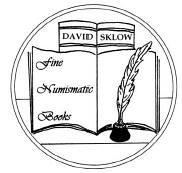 February 13, 2010, David Sklow-Fine Numismatic Books will close their 9th auction.
February 13, 2010, David Sklow-Fine Numismatic Books will close their 9th auction.
Catalogs available by request; Send inquiries to: David Sklow-Fine Numismatic Books, P. O. Box 6321, Colorado Springs, CO 80934. Telephone: (719)-302-5686; Fax: (719)-302-4933; Email: numismaticbooks@aol.com. The catalog is currently accessible on-line: www.finenumismaticbooks.com Bids will be accepted by, telephone, fax, email and regular mail.
Several sale highlights: Part One of The Q. David Bowers Research and Source Library; Selections from the Personal Library of Myron Xenos; Part One of the Rev. Russell Clunan Library of British Works; Several other Consignments.
- Photograph taken at ANA Convention Banquet 1942 of B. Max Mehl & Abe Kosoff
- [Editors Proof] A Buyers and Enthusiasts Guide to Flying Eagle and Indian Cents
- Q. David Bowers, Fixed Price List Number One Sept-Oct 1955
- [Copy # 1] American Coin Treasures and Hoards by QDB
- [Copy # 1] Obsolete Paper Money by QDB
- [Typescript] Colonial Book That Never Happened QDB
- [Editing Copies, Walter Breen, John J. Ford Jr.]1787 Brasher Doubloon Authenticated by QDB
- [Editors Pre-Publication Copy] Silver Dollars and Trade Dollars of the
- United States: 1993 [four volumes]
- Original Correspondence of Horce Louis Philip Brand
- Run of the British Museum Catalogue of Greek Coins: Forni reprints
- Empire State Numismatic Association the "Stater" Volumes I & II
- [Editors Pre-Publication Copy, With Actual Photographs and notes] The
- Cherrypickers Guide 3rd Edition
- Catalogue of the Calouste Gulbenkian Collection of Greek Coins Parts I & II [four volumes]
- The Kimonian Dekadrachms by Jongkees
- Original Correspondence of Walter P. Nichols
- Complete 1892-2000 bound set Spink Numismatic Circular Ex: British Museum Medal Room
- Deluxe Full Leather Bound Private Gold Coins and Patterns by Don Kagin
- Special Deluxe Superior Galleries Catalogs w/Photographic Plates
- Run of Frossard Catalogs
- Run of Lyman H. Low Catalogs
- Runs of Mason & Cogan Catalogs
- Run of Haseltine Catalogs
- Run of H.P. Smith Catalogs
- Run of Massamore Catalogs
- Run of Steigerwalt Catalogs
- Runs of Harzfeld, Sampson, Smith & Sampson, Strobridge, Birch & Sons, New York Coin Co.,
- Run of Scott & Co. Catalogs
- Deluxe leather bound numbered copy [#42 of 135] of Beistle on Early Half Dollars
- Deluxe leather bound California Pioneer Fractional Gold by Breen & Gillio [#24 of 100]
- Howard Newcomb's Deluxe numbered [# 3] copy of Ed Lee's California Gold
- Deluxe leather bound numbered [# 24 of 40] Peterson's Ultimate Guide to Attributing Bust Half Dollars
- Deluxe leather bound numbered [# 12 of 25] Souder's Bust Half Fever
- A very interesting leather bound Snowden Medals of Washington
- Three volume original leather bound set of Annals of the Coinage of Great Britain by Ruding
- American numismatic Biographies by Pete Smith
- Van Arsdell's Celtic Coinage of Britain
- Medallic Illustrations of the History of Great Britain & Ireland
- Sylloge of Coins of the British Isles-Six volumes of English Tokens in the
- Norweb Collection, by R.H. Thompson
- Very Rare ANA Monograph - Jungle Mints 1946
- Everybody's Coin Book - Rare ANA Monograph 1934
- Very Rare Deluxe editions of several auction catalogs by Federal Brand
- Walter Breen's Deluxe Bound Presentation copy of The Gainsborough Collection by Kreisberg
- Deluxe bound Rare Coin Reviews # 22 & 23 The Personal copies of James Ruddy
- Columbiana by Eglit
- Very Scarce - Coins of the World a Numismatography by Alfred White 1909
- The Deluxe leather bound 2007 NLG edition RedBook
- Wilson's Numismatic Repository
- Mr. Red Book [1978] by Numismatic News
- The Papers of Robert Morris - Six volume set
- Very Rare addenda sheet to Elder's sale # 210, ex: Armand Champa Library
- And MUCH MORE
………See our web site for the online catalog! Consignments are now being accepted for all future sales.
David Sklow-Fine Numismatic Books
P.O. Box 6321
Colorado Springs, CO 80934
PH (719)-302-5686
FAX (719) 302-4933
numismaticbooks@aol.com www.finenumismaticbooks.com
NEW BOOK: COINAGE OF THE ANGLO-HANNOVERIAN PERSONAL UNION 1714-1837
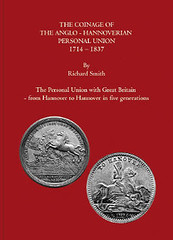
This new work by Richard Smith is the first comprehensive review of the Anglo-Hannoverian Regal coinage since Welter and will become an essential reference book for all those interested in this area of numismatics.
It is divided into two parts; the first deals with how the succession of the Brunswick-Luneburg Electors on the British Throne came about, their place on the world's stage, their titles and the main characteristics of the design of their coinage. An insight into the lives of these monarchs is given with a brief review of the history of the period. The structure of British and Hannoverian coinages are compared and described. The results of significant surveys are published for the first time giving an insight into the rarity of these coins.
BOOK REVIEW: A GUIDE BOOK OF UNITED STATES COINS (PROFESSIONAL EDITION)
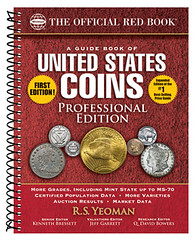 Over the past six weeks, I have turned to the new Professional Edition Red Book more often than to the older version. Now the bigger book is next to my desk. These are the coins that are interesting to write about. These are the facts that make history.
Over the past six weeks, I have turned to the new Professional Edition Red Book more often than to the older version. Now the bigger book is next to my desk. These are the coins that are interesting to write about. These are the facts that make history.
Perhaps most buyers of The Professional Edition will do nothing more than look up a price. However, studying the book for its metadata reveals the complex texture of collectible U. S. federal coinage. Large Cents are not Morgan Dollars. Pricing tables for the former begin with Very Fine up, whereas for the latter, only Mint State grades are tabulated. Similarly, the earliest Half Dimes are considered only for grades equal to or greater than EF-40, but the Draped Bust has a lower foundation, VF-20, because that is the reality of the market today.
The database schema accurately models more than today's markets. Large Cents have been pursued by pure hobbyists since the days of Lorin G. Parmelee and Edward Cogan. In the baby boom generation and before, amateur collectors monitored the media of daily commerce for a better circulated grade of an uncommon coin. Of course, today, that is greatly diminished.
More to the point, it was never the modality of the professional aficionado for whom citations to recent auctions always were more important than guesstimates of price. As collecting expanded and matured, the inventories of specimens in the highest grades grew. You can still build a nice collection of Jefferson Nickels with Full Steps by searching pocket change or bank bags, but the fact remains that nothing less than Full Steps is worth searching for. This book acknowledges that reality.
Intersecting sets of passions drive us numismatic bibliomaniacs. Whitman has established its own style for footnotes. The usual sequence is asterisk, dagger, double dagger, section mark, parallels and number sign, beginning at the top of the page. However, Whitman gives primacy to mintages. Therefore, the frequent note "Included in number above" always receives the asterisk and appears as the first footnote, regardless of where the noted tally appears on the page.
Next come the double and triple asterisks for other notes about mintages. Then comes the dagger. Whitman also relies on an alphabetic series (lowercase) to elucidate details of named varieties. Each sequence reinitializes with the major type, a-h for Liberty Seated Half Dollars, for example. None of this detracts in any way from the craft of this work It is merely a convention demanded by the subject matter, a nod to our uncommon and important library of knowledge.
BACK ISSUES OF REVUE BELGE DE NUMISMATIQUE FOR SALE
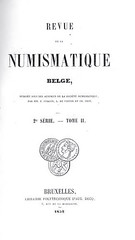 The Royal Numismatic Society of Belgium has decided to sell old copies of the Revue belge de Numismatique (RBN) it has still in stock, at promotion prices. Please note that the copies, some dating back to the 1850s, are unused, but that the covers may be a bit damaged; the contents are as new. The following prices apply (instead of the normal price of € 55 per copy):
The Royal Numismatic Society of Belgium has decided to sell old copies of the Revue belge de Numismatique (RBN) it has still in stock, at promotion prices. Please note that the copies, some dating back to the 1850s, are unused, but that the covers may be a bit damaged; the contents are as new. The following prices apply (instead of the normal price of € 55 per copy):
- for years preceding World War I: € 40 per copy
- for the years between World War I and 1960: € 20 per copy
- for the years after 1960 till 2000 (included): € 10 per copy.
Extra discounts apply in case of larger orders and for members. Please visit the website of the Society at www.numisbel.be, specify your language choice, and click on the blinking button marked RBN Sale for more information.
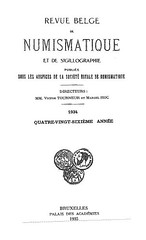
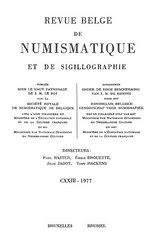
Jan provided the three covers illustrated here, one from 1852, one from 1934 and one from 1977. He adds:
Please note that the name of the Revue was originally Revue de la Numismatique belge, changing into Revue belge de Numismatique in 1875.
For more information, see: www.numisbel.be
REVIEW: KOLBE STACK FAMILY LIBRARY AUCTION CATALOG
Yesterday I received George Kolbe's catalogue of the New York City January 9th auction of Stack's family library. I quite literally couldn't put it down, try as I did. I kept re-opening it and digesting what I read. Not the actual auction lot descriptive listings themselves but the extensive small print notes after many lots. Incredibly fascinating and a look into the numismatic world as it used to be. Bill Anton and Mike Hodder, among others, wrote personal, heart-felt reminiscences of Stack's and the numismatic world as we "oldtimers" fondly remember it. I was transported decades back to a world where slabs, registry sets and one point differences in grade were unknown and unimportant.
Or that Tom Elder, a dean of numismatic dealers, commented in public print, specifying multiple customers by name, that "these clients who do not pay their bills are no better than thieves and belong in state prison."
Or that the first auction appearance of the super-rare 1792 silver disme (not half disme) was by dealer Edward Cogan in 1864 where he admitted it had been tooled to remove scratches and now was in "very excellent condition".
There are only 3 silver dismes known. Eliminating the Norweb III 1988, lot 3390 specimen which had been extensively tooled, removing the entire 1792 date the other Parmelee lot 1 "VG burnished both sides to remove initials", the implication is that the Cogan 1864 "very excellent condition" piece is the Dr. J. Hewitt Judd-Don Partrick "L.I. Collection" coin which had "several scratches carefully removed".
Thus, all three known 1792 silver dismes are damaged and/or repaired! This was a revelation to a 1792 pattern collector like me who had hoped some day to acquire a nice one. And there are many hundreds of other fascinating tidbits of information.
Even if E-Sylum readers do not anticipate bidding on the auction lots, the reminiscences of Stack's operation and offices (with excellent Stack Family photographs) and the extensive lot notations are worth acquiring this superb Kolbe auction catalogue. It's how the hobby used to be and will never again be. It's why so many numismatic oldtimers love this "hobby of kings" and don't want to let go until they have to.
Ray Williams writes:
You probably get tired of hearing it but thank you for this wonderful online publication. I'm writing in response to Arnold Miniman's letter in the December 20th E-Sylum. I don't know the reasoning or the sequence of events leading to the current administration of Stack's in New York. It is interesting to note that there is no Stack at Stack's and no Bowers at Bowers & Merena, but there is a Bowers at Stack's. How corporations evolve is unique to each one.
I too enjoyed the reminiscing of Michael Hodder, Bill Anton and Scott Rubin in the Kolbe catalog. I learned a lot about the family history that I didn't know, and the Stack family name will go down in history among the other great dealers in our hobby.
I didn't know any of the Stack family personally - just a few experiences on the auction floor when I was able to attend in person. But Roger Moore and I had an opportunity to do some lot viewing privately (perhaps it was the O'Donnell sale) and Harvey Stack walked up to the counter and greeted us. We closed our catalogs and listened to him talking about his years in the hobby.
The numismatics of the 40s, 50s and 60s came to life for us. We didn't mind at all losing the 15-20 minutes of lot viewing time to hear what stories he had. I hope he does write a book someday so that these stories aren't lost forever, and I hope that Dave Bowers and Eric Newman will also write their numismatic autobiographies.
But regardless of the public face placed on Stack's, the same quality people are there doing what they have done in the past while implementing the technologies of the future. I can sort of relate in that many people have commented to me that I'm the public face of C4 and what an outstanding club it is. But regardless of how good-looking my face is, it is the membership, workers and volunteers that make C4 outstanding. The public faces will change, but the mindset of the club will not.
Take a look at a Stack's advertisement in any numismatic publication - the faces are different than in years past. But look at the people who do the work today - they're all the same as before the leadership change. I have no reason to doubt that the cataloging excellence, and personal attention, will remain the same or even improve.
Alan V. Weinberg adds:
Having visited Stack's quite often in the 1960's I can positively say that group photograph was in the first half of the 1960's, definitely not in the 1950's.
THE BOOK BAZARRE
THE NATIONAL MUSEUM IN JAKARTA, INDONESIA
 There was a request for information a few weeks ago in The E-sylum which I thought could be answered by contacting the National Museum in Jakarta, Indonesia, so I sent Wayne the contact information. As it turned out, the information was outdated. So I contacted a friend in Jakarta, Will Tuchrello, who is the head of the U.S. Library of Congress office for Southeast Asia.
There was a request for information a few weeks ago in The E-sylum which I thought could be answered by contacting the National Museum in Jakarta, Indonesia, so I sent Wayne the contact information. As it turned out, the information was outdated. So I contacted a friend in Jakarta, Will Tuchrello, who is the head of the U.S. Library of Congress office for Southeast Asia.
He did not have the contact information in his Roledex so he asked a staffer to find it. This staffer, Arifin Pramono, called the museum and got the following information; Dra. Rodina Satrina is the Curator of the Numismatic Department. She does not have an email address, but the Curator of the Archaeology Department is (Dra. or Mrs.?) Desrika Widyastuti, and her email is desrika@yahoo.com. Desrika will print the emails and give them to Rodina.
The website address for the museum is now http://www.museumnasional.or.id, and the mailing address is Jl. Merdeka Barat No. 12, Jakarta 10110, Indonesia. The telephone numbers are 021-381-1551 or 381-2346 or 386-8171 or 386-8172. I have no idea who will be speaking on the telephone at those numbers, or even if they speak English. The Fax telephone numbers are 021-381-1076 or 344-7778.
I hope the person with the questions about a Dutchman in Indonesia can acquire the answers he wants from the above contact information. I am now back (December 24) from my three month trip to Southeast Asia and have to unpack and repack for the FUN Show, where I will have a club table for NBS and several other organizations. See you at FUN?
To visit the museum's web site, see: www.museumnasional.or.id
MORE ON THE PITTSBURG AND MEXICAN TIN MINING COMPANY MEDAL


George Fuld writes:
I just noted the discussion on the H-K 149 Pittsburgh token. I believe the first publication re this "medal" was in our Token Collector pages, in the Numismatist during 1952. It is in the Quarterman "Token Collector Pages" on page 45 along with two other tin mining pieces.
To read the earlier E-Sylum article, see: MORE ON THE PITTSBURG AND MEXICAN TIN MINING COMPANY MEDAL (www.coinbooks.org/esylum_v12n51a15.html)
GOLD CERTIFICATES VS FEDERAL RESERVE NOTES WITH GOLD REDEMPTION CLAUSE
An E-Sylum reader writes:
I'm continually amazed at how some fellow numismatists react to paper money articles in the E-sylum. I'm reacting to Joe Boling's comments in the latest issue of the E-sylum (see below). I should tell you up front that I've always admired Joe for his in-depth knowledge of areas in which he specializes. I would assume that small sized US paper money is not one of those areas. I don't want to beat a dead horse, but here are a few clarifications prompted by Joe's contribution last week:
1) When paper money collectors use the term 'Gold Notes', they are usually referring to Gold Certificates, not Federal Reserve Notes which happen to have the gold redemption clause. When I wrote that $10,000.00 Gold notes were unknown in private hands, I was referring to $10,000.00 Gold Certificates, not Federal Reserve Notes(FRN's). As I'm sure you know, small sized Gold Certificates have yellow seals, whereas small sized FRN's have green seals. The 1928 series small size FRN's have the gold clause. Later series of small size FRN's, such as the series of 1934, don't have the gold clause.
2) It is highly unlikely that either of the Binions displays would have contained $10,000.00 FRN's with the gold redemption clause. I believe the notes Parrino bought (from the second Million Dollar display) are all numismatically known (the series and serial numbers have been recorded in note census files). As I recall, all the notes Parrino bought were series 1934 from the New York Federal Reserve district. The 1928 series $10,000.00 FRN's are presently very scarce. If the earlier Binions display had been comprised of 100 pieces of the 1928 series $10,000.00 notes, the gold clause notes would probably be much more obtainable currently.
Martin Gengerke writes:
Your author is correct on all counts. Binion had no 1928 $10,000 Gold Certificates (only 1934 New York Federal Reserve Notes) in the famous display. At present there are only eight 1928 $10,000 Gold Certificates known, including two (or possibly 3) in government hands, and none are traceable to Binion's.
I'm not aware of a second Binion hoard, but don't believe there were any 1928 notes for the reason cited - they would be more common than they are, and their existence would have made big news.
The two people most "up" on the Binion notes are Stephen Sullivan and Carlson Chambliss - you might check with them - I strongly suspect they'll confirm what I've said.
To read the earlier E-Sylum article, see: MORE ON $10,000 GOLD NOTES AND JAY PARRINO (www.coinbooks.org/esylum_v12n51a14.html)
THE AMERICAN ANTIQUARIAN SOCIETY PRINTERS' FILE
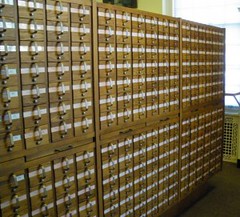 Avis G. Clarke, cataloger-cum-researcher of early American imprints and printers, filled hundreds of AAS card catalogue drawers with the AAS printers' file. Detailing the lives and works of virtually every printer working in America before 1820, the printers' file is a masterpiece of indexing.
Avis G. Clarke, cataloger-cum-researcher of early American imprints and printers, filled hundreds of AAS card catalogue drawers with the AAS printers' file. Detailing the lives and works of virtually every printer working in America before 1820, the printers' file is a masterpiece of indexing.
Comprising 134 drawers of biographical, printing, and publication history for a vast number of printers before 1820, and 11 drawers for the post-1820 period, the printers' file represents the perfect merger of detailed research and scholarly vision on the world of early American printing.
Ms. Clarke had to combine the skills of historian, genealogist, and bibliographer as she created the printers' file. She never judged or discriminated against the printers: each printer received his own set of cards, in some cases one or two and in others a half-drawer full. Ms. Clarke had to sort through some complex histories of printing families...
To read the complete article, see: Type Findings: Introducing the AAS Printers' File (pastispresent.org/2009/good-sources/type-findings-introducing-the-aas-printers-file/)
NUMISMATIC COMMUNICATION IN THE LAST DECADE
The first decade of the 21st century, which we close this week, will be known for vast changes in the numismatic field, but most importantly in how we communicate with each other. Internet. Email. The World Wide Web. Blogging. Google. The E-Sylum. Publishing on demand. CD publishing. Kindle. All things numismatic, from researching to putting numismatic literature in the hands of the individual numismatist, have changed in the last ten years. Numismatists have kept up with the technology.
That magic word "technology." Jeff Starck wrote a magnificent lengthy article on numismatic communication technology in the January 4th issue of Coin World. He covered what numismatists -- authors and dealers particularly -- are doing with new computer capability. We now have instant access, and virtually divine knowledge of the field with a few keystrokes. Got a question about any numismatic item? You are likely to learn the answer from your computer.
Stay tuned. The future will be even better. Numismatics will be more enjoyable for the information you will be able to garner about even the most insignificant item, and be overwhelmed with the data on the most prominent items.
Speaking of Jeff's technology article, we should extend an enormous debt of gratitude to Beth Deisher and the staff of Coin World for their four-part special issue to inaugurate the new year. "Technology: Changing, Shaping the Hobby." is an outstanding piece of journalism, covering paper money, coining technology, marketing in addition to Jeff's communication article. Well done.
Coin World does special editions well, ever since the first in 1960 on Civil War numismatics. We hope to see more such specials during the publication's 50th year and forward.
THE BOOK BAZARRE
QUIZ ANSWER: WHERE IS DATE ON THE NATIVE AMERICAN DOLLARS?
Last week I asked where to find the date on these coins (the Native American dollars).
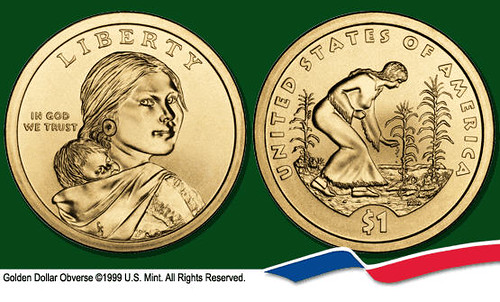
Jon Radel writes (correctly):
On the edge, which is why you couldn't find it quickly when describing the one you auctioned off a couple of weeks ago.
I'd forgotten about that - we had one of these coins in the auction for kids at the Annandale Coin Show. It's not obvious, even for a veteran numismatist, to look on the edge of a coin for the date.
QUIZ ANSWER: THE HIGLEY THREE PENCE
Pete Smith writes:
The image appearing on the Coin Rarities Online Christmas ad is adapted from a Higley copper produced near Granby, Connecticut.
Jeff Reichenberger writes:
Higley Copper. As wonderfully described in Will Nipper's In Yankee Doodle's Pocket. Apparently a favorite of Nipper's, it is reproduced on the title page, as well as stylized in copper foil on the front cover.
Gar Travis had the most specific response:
It is a copy of a Higley Three Pence (perhaps one of two in silver). According to the web site of the Special Collections of Notre Dame: "John Bolen of Springfield, Massachusetts created these dies in 1864 and minted 40 examples in copper and 2 in silver. Later Bolen sold the dies to F.S. Edwards who struck additional examples in nickel and others in brass." Source: http://www.coins.nd.edu/ColCoin/ColCoinText/Higley.1.html
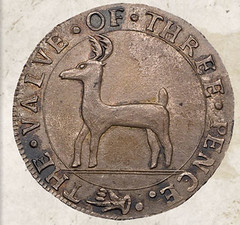
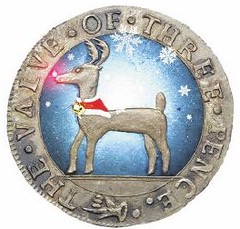
To read the complete article, see: MERRY CHRISTMAS! (www.coinbooks.org/esylum_v12n51a30.html)
VARIOUS TOPICS: BREEN, NEWSPAPER WEB SITES, AND MORE
Gregg Silvis writes:
Apropos your question concerning the discipline of Walter Breen's Master's degree, it was an M.A. in Sociology from the University of California, Berkeley in 1966. Here's a link to the catalog record: oskicat.berkeley.edu/record=b14936138~S1

Regarding last week's item on the Salvation Army coin donation, Joe Boling writes:
Berlin where? Salisbury where? Even going to the web site cited did not tell me where this town is. Is this the Salisbury on the eastern shore of Maryland? The names "Maryland," "Virginia," and "Delaware" do appear on the stub at the top of the page - but I'd like more information. I can't stand newspaper web sites that do not tell you where the city they are serving IS - and sometimes not even what the NAME of the burg is.
Amen! The rampant provincialism of local newspaper web sites worldwide strikes me as another example that print media still doesn't "get" the Internet. I do try to state where an article comes from, but often the web sites make it next to impossible to nail down their geographical origin. Rather than guess, I usually just give up.
Jim Duncan of New Zealand writes:
I thank you for a most interesting 52 newsletters. Has it ever been suggested that you publish a geographic breakdown of your subscribers? I know of only one other in NZ, Martin Purdy, but it would be interesting to know if there were more. No names of course, just numeric quantities. Cheers for 2010, and keep it up. I'm damned if I know how, I must say!
The year-end is a good time for reflection and annual surveys. I've been considering a survey of readers and just might have one in our next issue. What else would people like to know about their fellow E-Sylumites? Send me your questions for consideration.
One last thing - we're approaching the 100th anniversary of the landmark March, 1910 International Medallic Exhibition of the American Numismatic Society. How wonderful it would be to stage a similar high-profile exhibition of the finest medals in 2010.
QUERY: 1933 SAINT-GAUDENS DOUBLE EAGLE DOCUMENTATION
Another great issue of the E-sylum! The variety of topics and participating writers is overwhelming. The images of David Lange's library shelves filled with largely empty numismatic storage albums is truly "hardcore". A numismatist with scores of unfilled coin albums in a clean organized atmosphere is a true bibliophile.
Then there is the contribution from Ron Guth depicting George Kolbe at work. Again, a clean organized atmosphere while surrounded by the most important volumes in numismatics. It seems that these two gentlemen are setting a standard and dispelling the myth that book aficionados have dusty, musty piles of disheveled unread books cluttering every corner of their living space while calling it a library.
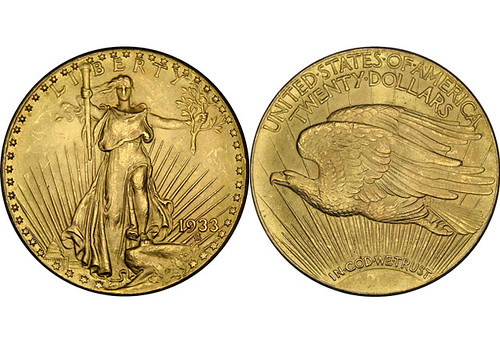
My questions to those who might know regards the images of the 1933 Saint Gaudens Double Eagle as Lot #70 on page 52 of the Stack family auction catalog from George Kolbe. It seems that repeatedly in any written context whenever this particular coin is mentioned the statement is made that all of the previously confiscated 1933 Saints that came into the possession of the United States Secret Service were "in fact" melted, except those in the National Numismatic Collection in the Smithsonian.
While I have personally seen that the Secret Service retains every counterfeit currency note that they recover as a reference library of sorts, I can't imagine that since they don't destroy these counterfeit notes that they would destroy the 1933 Double Eagles either. The few 1933's that have been confiscated clearly don't take up much space and they are meticulously recorded as to their sources, which would assist in an ongoing investigation since their first appearance after FDR's Executive Order halting their release. The destruction of the confiscated 1933's would seemingly harm the means for the Secret Service to authenticate future confiscated coins through die analysis.
I have never seen, nor heard of an official document that verifies the destruction of any 1933 Saint Gaudens Double Eagle. Are there any documents that provide dates and times of ANY 1933 Saint being melted and where would it have been done? If a melt occurred, how was the recovered gold recorded and what new form did it take? Has the speculation and presumption of melting after confiscation been taken as fact when there is no proof?
Provided that these coins do still exist the current legal ownership issue of the 10 confiscated specimens would have an effect on the return of the previously confiscated specimens as all would appear to have legality for their current and former owners. Can the subscribers and readers provide some insight for me?
THE BOOK BAZARRE
REWARD OFFERED FOR STOLEN S.S. CENTRAL AMERICA GOLD INGOTS
These ingots are highly identifiable, so please keep a look out for them in numismatic channels and elsewhere. The ingots are from assayers Kellogg & Humbert, Henry Hentsch, Justh & Hunter, Blake & Co., and Harris, Marchand & Co. -Editor
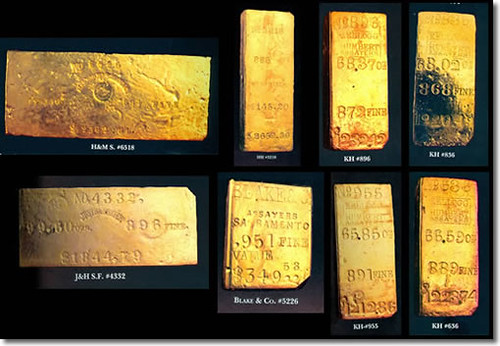
To read the complete article, see: $50,000 Reward Offered for Stolen Gold Ingots (www.coinnews.net/2009/12/23/50000-reward-offered-for-stolen-gold-ingots/)
THE 2010 BOY SCOUTS OF AMERICA CENTENNIAL SILVER DOLLAR
I don't usually have or take the time to comment on new coin designs from the U.S. Mint, but one coin caught my eye this week - the approved designs for the 2010 Boy Scouts of America Centennial Silver Dollar.
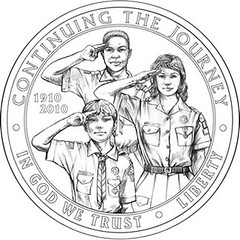

I like it, although I wonder if the obverse is TOO detailed and reverse has too little detail. Both LOOK great on paper (to me, anyway), but the true test is in how the final minted coins look in person.
The obverse depicts a Cub Scout in the foreground with a Boy Scout and female Venturer in the background saluting. Inscriptions include CONTINUING THE JOURNEY, 1910, 2010, IN GOD WE TRUST and LIBERTY. It was designed by Artistic Infusion Program Master Designer Donna Weaver and engraved by US Mint Sculptor-Engraver Charles Vickers.
The reverse features the universal emblem of the Boy Scouts of America. Inscriptions include UNITED STATES OF AMERICA, BOY SCOUTS OF AMERICA, BE PREPARED, E PLURIBUS UNUM and ONE DOLLAR. It was sculpted by US Mint Sculptor-Engraver Jim Licaretz.
The politically correct composition of the obverse figures of different races and genders is fine, but the inclusion of a girl on a Boy Scouts coin will cause some to wonder. It reminds me of the inevitable composition of corporate advertisements and brochures, and television show casts.
It also brought back the memory of a time in high school and an old TV show. A couple friends and I were walking down a city street one evening, and coming towards us were a group of three teenagers running - one white boy, one black boy, one white girl. My friend looked at them and said, "Dig it - The Mod Squad!". All six of us cracked up. (I guess you had to be there).
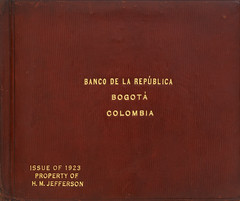
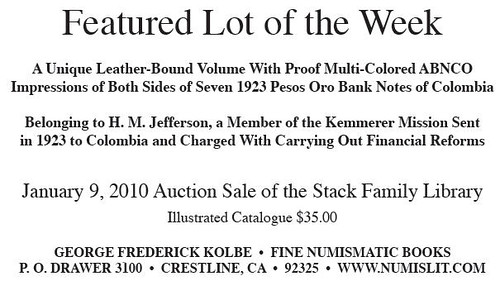
IRAN FIGHTS OPPOSITION SLOGANS ON BANKNOTES
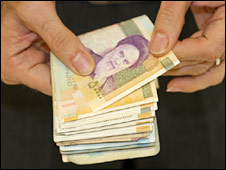 Iran's central bank has said defaced banknotes are to be made invalid, after the appearance of opposition slogans on money, local media report.
Iran's central bank has said defaced banknotes are to be made invalid, after the appearance of opposition slogans on money, local media report.
They quote bank official Ebrahim Darvishi as saying that people possessing defaced banknotes should exchange them by 8 January. It was difficult to distinguish genuine defaced notes from fakes, he added.
Messages in support of the opposition have been appearing on banknotes since June's disputed presidential election. Hardline President Mahmoud Ahmadinejad was re-elected in the poll - a move that triggered mass street protests by the opposition who claimed the election was rigged.
The bank official also called on the public and shop owners not accept such notes from 8 January. Since June's election, slogans such as "Death to the dictator" have appeared on many Iranian banknotes.
Many transactions are carried out in cash in Iran, which is under international banking sanctions and where major credit cards cannot be used.
To read the complete article, see: Iran 'to invalidate' banknotes defaced by slogans (news.bbc.co.uk/2/hi/middle_east/8430162.stm)
BOOTY CALL: ODYSSEY MARINE'S BLACK SWAN COINS ORDERED RETURNED TO SPAIN
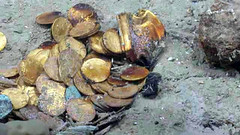 A U.S. district judge has ruled that U.S. treasure-hunting company Odyssey Marine Exploration should return to Spain a fortune in old coins recovered from the wreck of a 19th-century Spanish warship.
A U.S. district judge has ruled that U.S. treasure-hunting company Odyssey Marine Exploration should return to Spain a fortune in old coins recovered from the wreck of a 19th-century Spanish warship.
In an order filed in Tampa, Florida Tuesday, Judge Steven Merryday nevertheless directed that the return of the treasure to Spain be stayed until an appeals process in the case was concluded. It was the latest twist in a complex dispute over the treasure involving Spain, Odyssey and Peru.
Merryday's order backed a recommendation by a U.S. magistrate judge in June that Odyssey should hand over to the Spanish government nearly 600,000 silver and gold coins valued at some $500 million that it recovered from the wreck of the 19th-century Spanish warship Nuestra Senora de las Mercedes.
Spain said the Spanish naval frigate was carrying treasure back from Peru when it was sunk by British gunboats in 1804.
Odyssey Marine, which has disputed the treasure came from the Nuestra Senora de las Mercedes, discovered wreckage and the 17-ton haul of artifacts in March 2007 in international waters about 100 miles west of the Straits of Gibraltar, which separate Spain from North Africa.
"The ineffable truth of this case is that the Mercedes is a naval vessel of Spain and that the wreck of this naval vessel, the vessel's cargo, and any human remains are the natural and legal patrimony of Spain," Merryday said in his order.
Odyssey, which specializes in the recovery of sunken treasure and had codenamed this particular project "Black Swan," says the coin haul legally belongs to the company.
To read the complete article, see: $500 Million in Sunken Treasure Returning to Spain (www.foxnews.com/scitech/2009/12/23/plundered-booty-returning-spain/)
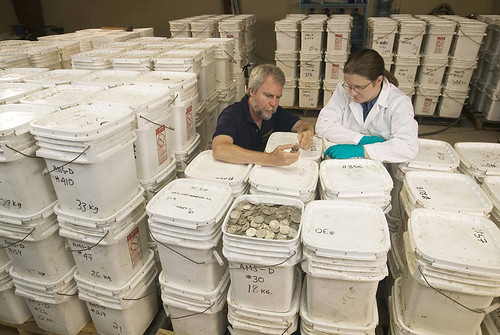
BARBER GETS 100 TRILLION DOLLAR TIP
A STUNNED barber thought he'd struck it rich after a well-travelled customer handed him a tip for a whopping 100 TRILLION DOLLARS – until he discovered the bank note isn't worth the paper it is written on.
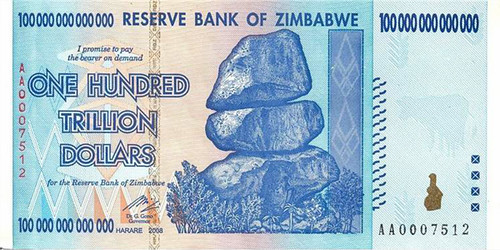
Vincent Evangelista could barely believe his eyes when the businessman gave him the note for 100,000,000,000,000 Zimbabwean dollars. But the barber soon found out that the currency from the crisis-torn African country – which has been hit by years of hyperinflation – is worthless.
Around a year ago, the massive note would only have been worth £20 – but today it holds NO VALUE at all after the currency was suspended by President Robert Mugabe's regime.
Vincent, who runs the popular Evangelista barber shop in Inchinnan Road, Renfrew, admits he had a fleeting thought of hanging up his scissors. That was until he realised he wasn't filthy rich after all.
"It's the biggest tip that I've ever been given," said 27-year-old Vincent.
"It's just a shame that it's not worth the paper it's written on.
"If it had been a note for US dollars, I could have retired, paid off the national debt and bought everyone a Christmas present with the change.
"I could have brought an end to the credit crunch in an instant."
After seeing his dreams of a life on ‘Trillionaire Row' dashed, Vincent was still able to see the funny side of it all.
To read the complete article, see: Barber thought he had struck the right note (www.paisleydailyexpress.co.uk/renfrewshire-news/2009/12/21/barber-thought-he-had-struck-the-right-note-87085-25425113/)
FEATURED WEB PAGE: CALENDAR MEDALS
This week's Featured Web page is the Token Corresponding Society's page on Calendar Medals.
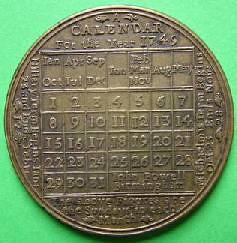
Calendar medals first appeared, in several countries of mainland Europe, during the 17th century. At their simplest, they told you the day of the week on which the Sundays occurred, or perhaps when the first of each month occurred, plus the number of days in those months. Many of them were much more elaborate, attempting to list a variety of astronomical phenomena, of which the lunar phases and sunset times rank amongst the more obvious.
The amount of data to be accommodated is considerable, in consequence of which the lettering is often very small and the pieces themselves decidedly large; 42-44 mm diameter is not uncommon, and anything up to 60mm possible. Most are in the range 37-44mm.
Most early pieces made use of the fact that, since there are seven days in the week and a leap year every four years, the pattern of days on which Sunday falls repeats every 28 years; thus, if you knew where in the cycle the current year was, and that was all you wanted to know, one piece would suffice for a long time. Others made lists of years for as many years as could be fitted on the piece. There were many experiments as to how to make the best use of the space available, and considerable variety of design in consequence.
www.tokensociety.org.uk/topics/calendar.shtml
